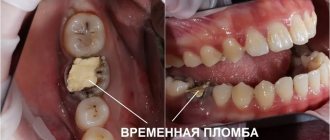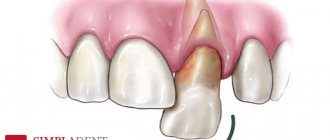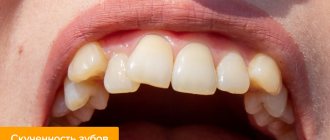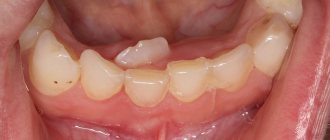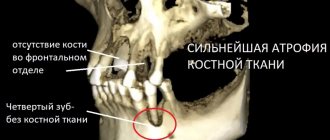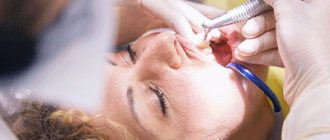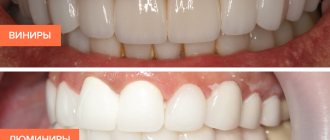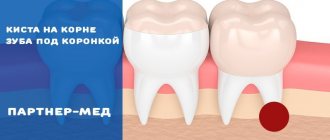When is root removal required?
It happens that only the root remains in the gum, and its crown part has been completely lost due to mechanical stress or untreated caries. After an X-ray examination, CELT specialists determine the possibility of treating such roots and their further use as a support for the crown. If this is not possible and the tissue surrounding the root is changed, a decision is made to remove it. Indications for root removal of front, broken, baby and other teeth are:
| Indications | Reasons for deletion |
| Serious damage to the crown of the tooth | Complete fracture of the crown, complex transverse fracture, fracture along the lobar axis, as well as destruction of the tooth crown below the gum level |
| Inflammatory processes | Development of inflammation in the root area in the form of a cyst, granuloma, abscess or phlegmon |
| Dentofacial anomaly | The tooth that is to be removed has an atypical location and prevents other teeth from growing, injures the gums and causes discomfort |
| Movable root | Third degree of tooth mobility |
It is worth noting that the crown part of the tooth can be destroyed both on a tooth with a nerve and on a pulpless tooth. If the tooth is “alive” and the destruction of its coronal part is not severe, its preservation is quite possible. As for a tooth with a removed root, the latter, as a rule, are seriously damaged and their restoration is quite difficult. In this case, the doctor may recommend removal of the tooth root and subsequent implantation.
When should a lower tooth not be removed?
If we talk about contraindications to surgical intervention, then it will have to be postponed if:
- Cardiovascular pathologies. It is necessary that at least three to six months have passed after a hypertensive crisis, heart attack, coronary disease and other severe cardiac pathologies.
- Acute diseases of the kidneys, liver, pancreas.
- ARVI and ARI. This refers to flu, colds, pneumonia, etc.
- Disturbances in the functioning of the cardiovascular system, for example, with meningitis, encephalitis, problems with cerebral circulation.
- Exacerbations of mental illness.
- Untreated diseases of the oral cavity - stomatitis, gingivitis, gumboil, etc.
As soon as the underlying disease is cured, extirpation can be performed immediately, but not before. Otherwise, the recovery process will be delayed and complicated.
Removing the root of a decayed tooth
Cases where a root remains after tooth extraction are not uncommon. Its removal is a difficult and unpleasant procedure for the patient, even despite the effectiveness of modern anesthesia. Fortunately, the need to remove tooth roots does not always arise. If the root is healthy enough, it is treated and prosthetics are performed. However, removing a rotten tooth root is simply necessary, since its preservation will entail a number of problems:
- Halitosis (bad breath);
- A breeding ground for infection in the oral cavity, possible damage to neighboring teeth;
- The appearance of subgingival stone;
- Spread of infection to the maxillary sinuses, development of osteomyelitis;
- The appearance of cysts and granulomas at its apex ( removing a tooth with a cyst on the root
is a complex procedure); - A decrease in the body’s overall immunity due to the fact that it is forced to constantly fight the source of inflammation.
In order to properly plan the operation, our dentist performs an x-ray examination. The operation itself is performed using local anesthesia, dental forceps or an elevator. Removing the roots of the front teeth
is carried out using rotational movements, and lateral movements using rocking. The most complex cases may require additional manipulations, the use of burs and special microsurgical dental instruments. Removing the roots of the teeth of the lower and upper jaw is a more complex procedure than removing a whole tooth. It requires special training, which consists of examination, diagnosis and sanitation of the oral cavity. The treatment plan is drawn up based on diagnostic studies and the patient’s indications.
Oral care after lower tooth extraction
Upon completion of the dental intervention, the doctor gives the patient recommendations on how to behave so that the recovery is successful and in the shortest possible time. Necessary:
- Do not eat anything for the first two to three hours after treatment. It is important that a clot forms in the hole, which will protect it from the penetration of bacteria.
- Do not touch the wound with your tongue or foreign objects.
- Do not use paste or brush on the day of the procedure.
- Rinse your mouth only if prescribed by your doctor.
- Visit the doctor on the appointed day for a follow-up examination.
It is important to understand that dental operations today are only vaguely reminiscent of those performed a couple of decades ago. They are as gentle as possible and are not associated with pain and long-term rehabilitation.
Root removal steps:
- Carrying out activities for the administration of a local anesthetic drug;
- Separation of the circular ligament from the neck of the tooth, moving the gum tissue away from the edge of the alveolus;
- Cutting the gums and drilling out the bone tissue to provide access to the root (if necessary);
- The process of removing the root using forceps or a dental elevator. If a tooth has several roots, removal is carried out in parts;
- Treatment of the hole, suturing (if the gum is cut), treatment of the operated area.
It is important to understand that removing roots located on the upper jaw is different from removing roots located on the lower jaw. In the first case, special forceps are used, in the second - elevators. The technique for removing the roots of the upper jaw involves twisting single roots and dislocating parts of one root. As for the roots of the lower jaw, they are twisted.
Symptoms that require you to see a dentist
Preventive visits to the dentist are recommended every 6–12 months, even if there is nothing disturbing. This will help prevent disease or reduce the cost of dental treatment, which is always lower at an early stage. The following symptoms should be the reason for a mandatory visit to a specialist:
- reaction of teeth to temperature and chemical stimuli (cold, hot, sweet);
- pain in the tooth, even in the absence of visible damage or defects;
- bleeding gums when brushing or biting on hard foods;
- a sharp change in the color of the tooth or the appearance of spots or stripes on it.
In addition, you need to visit a dentist when planning a pregnancy in order to identify and eliminate diseases of the oral cavity.
How much does tooth root removal cost in Moscow?
The cost of tooth root removal is determined individually, as it depends on how complex the case is. In the dental department of the multidisciplinary clinic CELT, it starts from 800 rubles for a simple removal and ends at 10,000 rubles for a complex removal of a 2nd degree dystopic tooth. You can view our basic prices in this section of our website. In order to find out the exact cost of tooth root removal in our clinic in Moscow, consult our specialist.
In the dentistry of the CELT clinic, you can get a consultation with a dental surgeon, undergo an examination and remove the roots of the teeth, if there are indications for this. We will eliminate any dental problems effectively and absolutely safely.
Endodontic dental treatment
Restoration of a crown affected by caries is carried out in one step. The doctor restores its shape and color, having previously cleaned and sealed the resulting cavity. More complex and lengthy dental treatment in dentistry is used if the carious process has spread to the pulp chamber and canals. In such a clinical situation, endodontic intervention is indicated. Its stages:
- Injection of a local anesthetic to numb the affected tooth.
- Drilling out carious tissues and creating access to root canals.
- Medicinal antiseptic treatment and drying of the cavity.
- Application of devitalizing (nerve-killing) paste and temporary filling.
When treating pulpitis, the patient has to visit the dentist two or three times. At the final stage, the doctor installs a permanent filling and restores the anatomical shape of the crown.
Reviews of doctors providing the service - Tooth root removal
I would like to express my gratitude to the dentist Elena Nikolaevna Kiseleva and her assistant Svetlana - they are real specialists and at the same time sensitive, not burnt out by years of practice.
Thanks to them, I have been coming back here for many years. Thanks to the management for such doctors! Read full review Svetlana Nikolaevna
13.08.2021
I am very grateful to Evgeniy Borisovich Antiukhin for removing my three eights. Especially considering that the lower tooth was not the simplest (it was located in an embrace with a nerve). The removal took place in 2 stages, one tooth under local anesthesia, two under general anesthesia. I had no idea that wisdom teeth could be... Read full review
Sofia
28.12.2020
Modern methods of dental treatment
Many patients traditionally associate dental treatment in a clinic with the buzzing sound of a drill. This device is really necessary for the preparation of dental tissues. But modern methods make it possible in some cases to do without it. Such technologies, in particular, include:
- Remineralizing therapy. This non-invasive treatment method is based on the use of external calcium and fluoride preparations at the very first stage of caries, when there is no obvious defect yet, but softening of the enamel is already noticeable.
- Ozone therapy. The essence of the method is to treat dental tissues affected by caries with triatomic oxygen. At the same time, healthy enamel is preserved, and pathogenic microorganisms are completely destroyed by ozone.
- Icon Method. The damaged area is treated with a polymer composition that destroys bacteria, seals the affected area and restores the density of tooth enamel.
Innovations also include dental treatment under a microscope. When used, it is possible to save even seemingly hopeless units from removal.
Causes and consequences of losing the seventh teeth
Tooth loss usually occurs due to chronic diseases. Sevens are at risk - they are subject to heavy loads when chewing food, and their location does not allow for high-quality hygiene at home. Together, these factors lead to the rapid development of caries, pulpitis and crown destruction. Following the crown, inflammation moves to the root, periodontitis occurs, the formation of granulomas and cysts. If not treated in a timely manner, the inflammatory process spreads over large areas, which leads to the removal of the source of infection. Other reasons:
- periodontitis;
- jaw injuries;
- bone atrophy due to age-related changes;
- congenital anomalies.
The loss of even one unit of dentition leads to the following consequences:
- malocclusion - voids in the dentition lead to a displacement of neighbors towards the missing unit, while the jaws will no longer close as tightly as before;
- diseases of neighboring teeth - when tilted towards the defect, the necks become exposed, sensitivity and inflammation occur;
- diseases of the digestive system - food is not chewed properly, pathologies of the stomach and pancreas develop;
- bone atrophy - due to root loss, the load on the jaw decreases and it becomes thinner;
- change in appearance - tired appearance due to sunken cheeks and wrinkles.
Recovery methods
You can restore sevens by:
- fixation of a dental bridge;
- installation of a removable denture;
- implantation
A bridge in the absence of one tooth consists of three crowns. The outer ones are fixed on the supporting teeth, and the middle one compensates for the lost unit. Since the seventh tooth is usually the end tooth, there is nothing to attach the permanent bridge to. In this case, removable structures are used.
Removable dentures are fixed on the teeth on one side, and glued to the gums with a special gel on the other. This is an inexpensive option, but unreliable - the fixation of the prosthesis is unstable and does not provide functional qualities.
Implants completely imitate the structure of the tooth and are the best solution to the problem. A titanium root is screwed deep into the jaw, and a crown is placed on top. Neighboring units of the dentition are not involved in any way. An artificial tooth is no different from a natural one and takes the same chewing loads.
- Dental bridge
- Removable denture
- Implantation
Price
The cost of installing an implant in our Center is standard. Pricing is formed on a turnkey basis. There are several ready-made treatment options. For example, using Nobel Biocare PMC implants, restoring a seven is 20 thousand cheaper than installing a Nobel Biocare Conical Parallel CC. The first ones are used for weak bones, the second ones - of the new generation, for strong ones.
The operation takes place in two stages. At the first, the price includes the procedure itself, the implant and plug, pain relief, consumables, postoperative X-ray examination and CT scan after eight weeks. The application and removal of sutures are also taken into account when determining the cost.
At the second surgical stage, the price list includes painkillers, antiseptics, opening and removal of implant plugs, fixation of gum formers, and consumables.
In the “implantation” case, the cost of surgical treatment does not include crowns. The price depends on the manufacturing method and type of fixation.
Our Center has its own laboratory, where only all-ceramic crowns are manufactured using the Zirkonzahn Schule method. You can order production at the Swiss PROCERA plant, but you will have to wait longer.
The cost of the case does not include sanitation, sinus lift, osteoplasty and temporary prostheses until the implants are healed.
We begin implantation of a living tooth
Now it’s time to install our model’s extracted tooth into the socket - a fitting that repeats the shape of the root of the eighth tooth, which we talked about earlier. And the shape of this root does not yet correspond to the sockets of the tooth in which the roots of the six were located. Therefore, the holes at the site of tooth extraction are corrected with a bur until we obtain the required size and configuration for the stereolithographic model, which, in turn, ensures that the space for the new tooth remains intact.
In the photo you see that the tooth model is fitted
. The time from preparation to fitting takes from 5 to 10 minutes.
When we use a stereolithographic tooth, as soon as we remove the problematic tooth, immediately after 10 seconds we begin preparing and installing the model. And only after this we proceed to remove the figure eight, followed by implantation of a wisdom tooth in the place now occupied by the stereolithographic model.
Will the molar replace the removed one?
It is also important when implanting your own tooth that as soon as we extract the donor tooth with its roots and periodontal ligament, we must immediately begin installing it in place of the implanted tooth. Since this place is currently occupied by a sterolithographic model, while my assistant was removing it, I had a few seconds to photograph the figure eight, our donor tooth
:
Please note that there is a periodontal ligament
, which we talked about earlier. Now the implantologist has a strict time limit, no more than 20 minutes. Since if you do not promptly insert a new tooth in place of the removed one, then within 20 minutes this ligament will completely die. The periodontal ligament contains blood vessels, which then help the tooth to osseointegrate and grow into a new place. The tooth receives its nutrition from this ligament.
Therefore, each operation to transplant an extracted tooth is preceded by careful preparation, which includes:
- computed tomography,
- preparation for donor tooth extraction,
- production of an accurate model of the donor tooth on a 3D printer.
How the upper eight, donor tooth, was atraumatically extracted
The tooth we need is impacted upper eight 1.8
, while hidden, is located under the gum. As you can see in the photo, a neat cut has been made at the location of the figure eight. This is what the tooth looks like on a tomography:
The following photo shows how we slightly exposed the tooth for subsequent extraction:
After atraumatic removal of the figure eight, the wound was carefully sutured:
And now we want to show you how accurately the tooth model replicates the root of the figure-eight tooth we implant:
Look at the precision of manufacturing. Almost identical configuration and size of the model! The technology of tooth transplantation and implantation of living teeth has largely become possible thanks to digital dentistry, using:
- computed tomography,
- stereolithography technologies,
- digital 3D scanning,
- printing models on a 3D printer.
As a result of wisdom teeth transplantation, we receive the so-called wisdom teeth in place of the removed problematic tooth. "tooth of a new generation" The benefits of eight teeth in the age of digital technology are becoming obvious and in demand.
Implantation of a living tooth in place of the lower six
You see that the artificial tooth has been removed, and in its place a living impacted tooth-eight, which has been hidden in the gum all its life, has been transplanted. Figuratively speaking, “a child was born and immediately began his life in a new place.” In any other case, this eight would have been removed someday and would have been of no use. But in this case, its role in restoring the patient’s dentition is the main one, and thanks to the presence of a wisdom tooth in good condition, such a jewelry operation became possible.
The transplanted tooth is sutured and fixed tightly in the gum so that there are no empty spaces around its root.
The installed tooth is still slightly short of normal bite, but in the future it is planned to cover this tooth with a ceramic crown.
In 2 weeks
A general practitioner from the Research Center removed the nerves in the implanted tooth under a microscope, and the canals were carefully sealed. In general, the nerve in the transplanted tooth-eight can take root only if the patient is under 20 years old. This is the age when the roots of the wisdom tooth are not yet fully formed. And if the root has formed, then there is no longer a growth zone and, accordingly, it has no growth potential.
Is it possible to place a crown right away?
A one-stage technique with instant loading involves the rapid restoration of lost teeth - the titanium root is loaded with a temporary crown for a maximum of 3 days after surgery. But this method is only suitable for replacing teeth that do not take part in chewing (premolars - fours, fives).
This method is not recommended for second molars. When eating, the sevens are subject to stress, which leads to displacement of the implant. Therefore, the crown is installed after healing, when the root has firmly grown into the bone. Until osseointegration is completed, the patient wears a lightweight removable denture. It is attached to adjacent teeth and does not load the implant. If the patient insists on immediate installation of a crown, the clinic does not provide a guarantee for the implant system.
If the patient insists on immediate installation of a crown, the clinic does not provide a guarantee for the implant system.
Guarantees
The Center for Private Dentistry “Doctor Levin” has a guarantee program. The patient of the clinic will receive a guarantee for:
- implant;
- surgery;
- sinus lifting and osteoplasty;
- prosthetics.
Only Lifetime on Nobel Biocare issues a lifetime warranty on the implant; other companies usually provide 25 years.
The warranty provides a year of free service for implantation and two years for all types of treatment. The contract is valid subject to systematic medical examinations and proper care.
